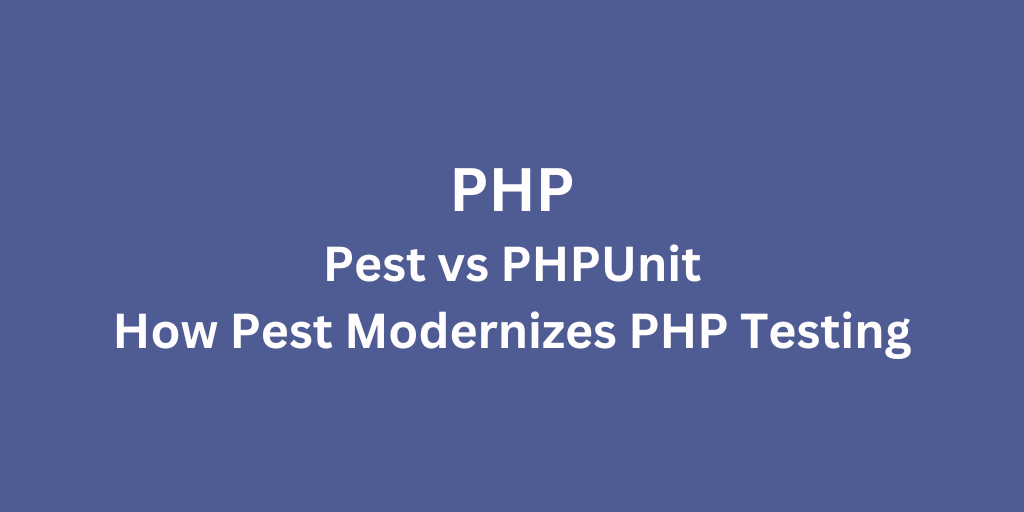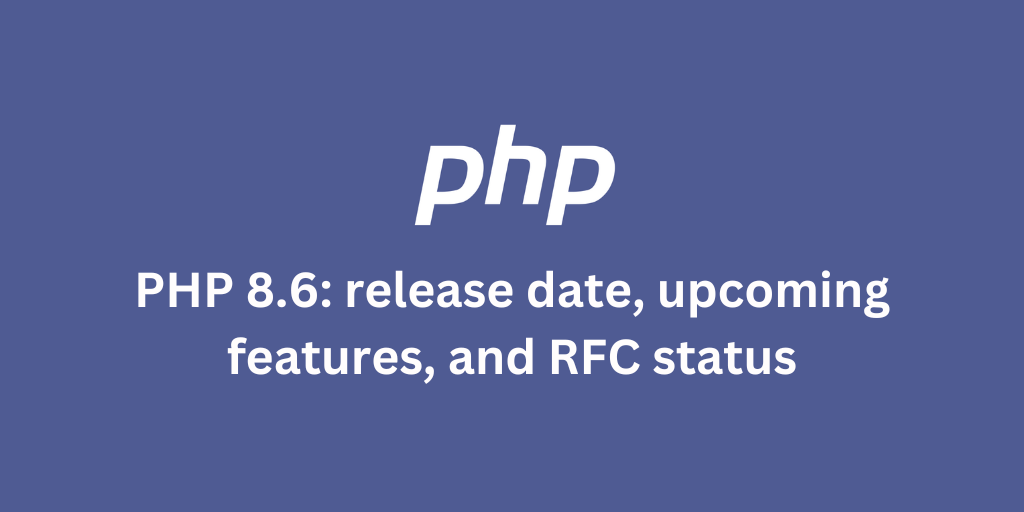Pest vs PHPUnit: How Pest modernizes PHP testing

- PHPUnit vs Pest: PHP Testing Framework Comparison
- Expectations API with fluent chaining and custom extensions
- Functional test style with describe, it, higher order tests
- Datasets that read naturally inline
- File and suite configuration via Pest helpers
- Lifecycle hooks expressed as closures across files or globally
- Grouping with fluent API and directory level grouping
- Browser testing built on Playwright
- Architecture testing
- Snapshot testing
- Type coverage reporting
- Profanity checker and more
- Filtering and running tests with fluent chains in code
- Side by side summary
- Practical starter templates
- Conclusion
PHPUnit vs Pest: PHP Testing Framework Comparison
Testing is a non-negotiable part of modern PHP development. Among the most widely used frameworks, PHPUnit and Pest stand out as the dominant choices. Both are powerful, reliable, and actively maintained but they differ significantly in philosophy, syntax, and developer experience.
PHPUnit is the long-established standard in PHP testing, powering most enterprise and open-source test suites. It follows a traditional, class-based structure familiar to Java or .NET developers.
Pest, on the other hand, is a newer testing framework built on top of PHPUnit. It redefines PHP testing with a simpler, expressive, and elegant syntax while maintaining full PHPUnit compatibility.
Expectations API with fluent chaining and custom extensions
Pest introduces expect() with readable matchers and a first class way to create your own expectations. PHPUnit relies on assertion methods and custom constraints but has no built in fluent expectation layer.
Example
// Pestexpect($user->name)->toBe('John')->not->toBeEmpty(); // Custom expectation in tests/Pest.phpexpect()->extend('toBeAdult', function () { return $this->toBeGreaterThanOrEqual(18);}); // Usageexpect($user->age)->toBeAdult();Functional test style with describe, it, higher order tests
Pest adds describe() and it() helpers and a higher order testing mode that removes boilerplate closures for common flows. PHPUnit stays class based and does not offer these helpers.
Example
// Pestdescribe('sum', function () { it('adds integers', function () { expect(sum(2, 3))->toBe(5); });}); // Higher order style exampletest('home page')->get('/')->assertOk()->assertSee('Welcome');Datasets that read naturally inline
Pest provides inline datasets and named datasets via ->with(...). PHPUnit has data providers, but the inline, fluent dataset style is a Pest convenience feature.
Example
it('accepts valid emails', function (string $email) { expect($email)->toMatch('/@/');})->with([]);File and suite configuration via Pest helpers
Pest lets you bind a base test case, traits, and groups to files or directories using pest()->extend(), pest()->use(), and ->in(). PHPUnit config is XML oriented and class based. The fluent per directory binding is Pest specific.
Example
// tests/Pest.phpuse Tests\TestCase;use Illuminate\Foundation\Testing\RefreshDatabase; pest()->extend(TestCase::class) ->use(RefreshDatabase::class) ->in('Feature');Lifecycle hooks expressed as closures across files or globally
Pest has beforeEach, afterEach, beforeAll, afterAll hooks with a functional style and global registration in tests/Pest.php. PHPUnit offers setup and teardown methods but not the closure based, global hook ergonomics.
Example
beforeEach(function () { $this->user = User::factory()->create();}); afterAll(function () { // clean up external resources});Grouping with fluent API and directory level grouping
Pest adds ->group('name') and directory wide grouping through pest()->group()->in(). PHPUnit uses annotations or attributes but not the same fluent helpers.
Example
test('slow path', fn () => /* ... */)->group('slow'); // Directory levelpest()->group('feature')->in('Feature');Browser testing built on Playwright
Pest v4 adds browser testing through an official plugin with simple visit() flows, screenshots, and visual regression helpers. PHPUnit does not include browser automation out of the box.
Example
it('welcomes the user', function () { $page = visit('/'); $page->assertSee('Welcome');});Architecture testing
Write rules that enforce boundaries and naming by namespace or function patterns. This is a built in capability in Pest docs through the Architecture Testing section. PHPUnit has no native architecture rule DSL.
Example
arch() ->expect('App\\Http\\Controllers') ->toUse('App\\Http\\Requests');Snapshot testing
Simple snapshot matching with a dedicated storage folder managed by Pest. PHPUnit does not ship a snapshot feature.
Example
it('renders contact page', function () { $response = $this->get('/contact'); expect($response)->toMatchSnapshot();});Type coverage reporting
A plugin that reports type coverage without executing tests. PHPUnit does not provide this metric natively.
Command
composer require --dev pestphp/pest-plugin-type-coverage./vendor/bin/pest --type-coverageProfanity checker and more
Additional official plugins like Profanity and Stress testing are documented and integrate via the same fluent CLI options. PHPUnit does not have official equivalents.
Filtering and running tests with fluent chains in code
Beyond CLI flags, Pest lets you chain helpers like ->group() at call sites and use expressive describe based scoping. PHPUnit filtering is attribute or CLI driven and remains class centric.
Side by side summary
| Feature | Pest | PHPUnit |
|---|---|---|
| Expectations API | Fluent expect() API with custom expectations via expect()->extend() |
Traditional assertion methods using $this->assert*() |
| Test Structure | describe() and it() helpers for behavior-driven tests |
Class-based TestCase structure with methods |
| Datasets | Inline and named datasets using ->with() |
Data providers defined as separate methods |
| Suite Configuration | Fluent configuration with pest()->extend(), pest()->use(), ->in() |
XML-based configuration or annotations |
| Hooks | Closure-based beforeEach, afterEach, beforeAll, afterAll (global or file-level) |
Method-based setUp() and tearDown() in classes |
| Grouping | Fluent ->group() and directory-level grouping |
Grouping via annotations or attributes |
| Plugins | Official plugins for browser, architecture, snapshot, type coverage, profanity, and more | No official plugin ecosystem; relies on external tools |
Practical starter templates
Convert a PHPUnit assertion to a Pest expectation
// PHPUnit$this->assertSame(5, sum(2, 3)); // Pestexpect(sum(2, 3))->toBe(5);Add a reusable expectation
// tests/Pest.phpexpect()->extend('toBeUuid', function () { return $this->toMatch('/^[0-9a-f]{8}-[0-9a-f]{4}-[1-5][0-9a-f]{3}-[89ab][0-9a-f]{3}-[0-9a-f]{12}$/i');}); // usageexpect($id)->toBeUuid();Attach a base TestCase and a trait across a folder
// tests/Pest.phpuse Tests\TestCase;use Illuminate\Foundation\Testing\RefreshDatabase; pest()->extend(TestCase::class)->use(RefreshDatabase::class)->in('Feature');Define architecture rules
arch()->preset()->php(); // start with sensible defaultsarch()->expect('App\\Models')->toOnlyBeUsedIn('App\\Services');Add a snapshot check
it('has a contact page', function () { $response = $this->get('/contact'); expect($response)->toMatchSnapshot();});Minimal browser test
it('may welcome the user', function () { $page = visit('/'); $page->assertSee('Welcome');});Conclusion
Pest offers more features in addition to the ones I covered in this blog post. Choose PHPUnit when you want the classic class based xUnit core. Choose Pest if you want the same engine with an expressive API, functional test style, and an official plugin ecosystem that covers browser automation, architecture rules, snapshots, and type coverage out of the box.
Stay Updated.
I'll you email you as soon as new, fresh content is published.


